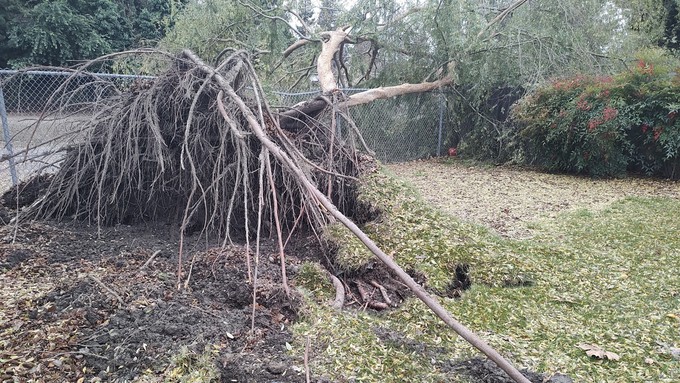
Sacramento's urban forest took a big hit from storms

This elm in the Pocket was one of the early victims of the current series of storms. Debbie Arrington
Besides dumping an amazing amount of rain, these ferocious winter storms have packed a wallop to Sacramento’s famous urban forest. By reported estimates, the City of Trees lost nearly 1,000 trees since New Year’s Eve – and that’s not counting what came down in the wee hours of Tuesday morning.
The City of Sacramento reports that it received about 700 requests for downed tree removal in the first six days of January. Many more requests have come in since.
Removal is a slow process. In that first week, city crews were able to deal with about 200 of the downed trees. Part of the problem? Not enough cranes. Fallen giants weigh tons.
One particularly large victim: The giant sequoia at Capitol Park. About a century old, the mammoth redwood went over and took most of a neighboring Torrey pine with it.
Some Sacramento County and city parks lost dozens of trees. In Yolo County, the UC Davis Arboretum lost at least 15 otherwise healthy trees including a Guadalupe Island cypress planted in 1936.
A combination of saturated soil and extreme wind gusts – some over 60 mph – brought down these big trees, many of which had roots weakened by years of drought.
Through Jan. 9, downtown Sacramento has received 4.48 inches of rain this month. That was on top of 9.52 inches in December including a record 2.37 on New Year’s Eve. That’s nearly 7 inches in 10 days – almost as much rain as Sacramento received in all of 2020. Before December’s deluge, Sacramento’s rain total for the first 11 months of 2022 was 4.31 inches.
So much rain has saturated our slow-draining clay soils. Trees are literally standing in slippery mud, and they’re losing their grips on their soggy toeholds. At some point, those roots start to give way. Called soil separation, this process can form cracks on the surface – like little earthquake faults running through the lawn. It’s one of the few warning signs before a tree goes down.
Cypress, elms and redwoods are among the most common victims of these January storms but so are many other species, especially those with leaves or needles. Foliage on evergreen trees can create a giant sail to catch wind gusts, strong enough to push it over or rip off branches.
Drought’s long-term effects can be seen in the roots of fallen trees. Healthy tree roots grow deep and stretch out as far as the tree’s canopy – the outer reach of its limbs. But often, these toppled giants reveal rootballs that are barely wider than their trunks. Such was the case in Midtown, where fallen 60-foot trees had rootballs no wider than their space between the street and sidewalk. Roots had died back so much, they were no longer strong enough to hold the tree upright.
The solution: Keep trees as healthy as possible before storms hit. That includes deep, infrequent irrigation to encourage strong roots.
In the meantime, watch out for those soil cracks around trunks and be ready for more falling branches. According to the National Weather Service, more rain and wind is in the Sacramento forecast at least through Monday.
For more on tree care and how to hire an arborist: www.sactree.org.
Comments
0 comments have been posted.Sacramento Digs Gardening to your inbox.
Food in My Back Yard Series
May 6: Maintain soil moisture with mulch for garden success
April 29: What's (already) wrong with my tomato plants?
April 22: Should you stock up on fertilizer? (Yes!)
April 15: Grow culinary herbs in containers
April 8: When to plant summer vegetables
April 1: Don't be fooled by these garden myths
March 25: Fertilizer tips: How to 'feed' your vegetables for healthy growth
March 18: Time to give vegetable seedlings some more space
March 11: Ways to win the fight against weeds
March 4: Potatoes from the garden
Feb. 25: Plant a fruit tree now -- for later
Feb. 18: How to squeeze more food into less space
Feb. 11: When to plant? Consider staggering your transplants
Feb. 4: Starting in seed starting
Sites We Like
Garden Checklist for week of May 11
Make the most of the lower temperatures early in the week. We’ll be back in the 80s by Thursday.
* Plant, plant, plant! It’s prime planting season in the Sacramento area. Time to set out those tomato transplants along with peppers and eggplants. Pinch off any flowers on new transplants to make them concentrate on establishing roots instead of setting premature fruit.
* Direct-seed melons, cucumbers, summer squash, corn, radishes, pumpkins and annual herbs such as basil.
* Harvest cabbage, lettuce, peas and green onions.
* In the flower garden, direct-seed sunflowers, cosmos, salvia, zinnias, marigolds, celosia and asters. (You also can transplant seedlings for many of the same flowers.)
* Plant dahlia tubers.
* Transplant petunias, marigolds and perennial flowers such as astilbe, columbine, coneflowers, coreopsis, dahlias, rudbeckia and verbena.
* Keep an eye out for slugs, snails, earwigs and aphids that want to dine on tender new growth.
* Feed summer bloomers with a balanced fertilizer.
* For continued bloom, cut off spent flowers on roses as well as other flowering plants.
* Add mulch to the garden to maintain moisture. Mulch also cuts down on weeds. But don’t let it mound around the stems or trunks of trees or shrubs. Leave about a 6-inch-to-1-foot circle to avoid crown rot or other problems.
* Remember to weed! Pull those nasties before they set seed.
* Water early in the day and keep seedlings evenly moist.